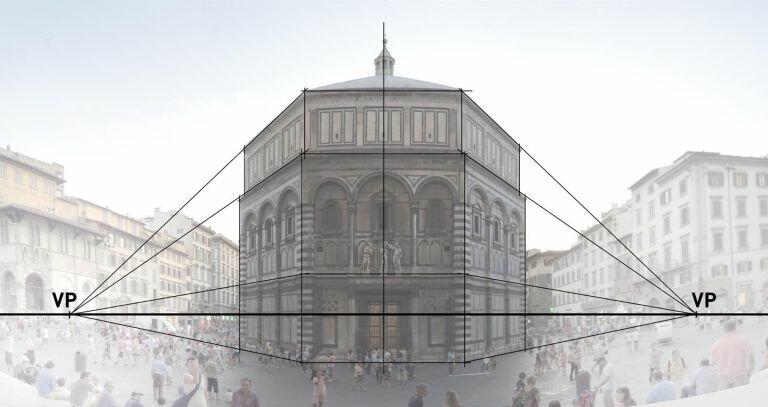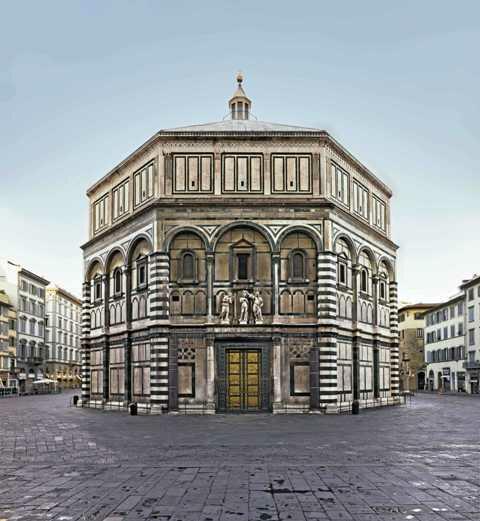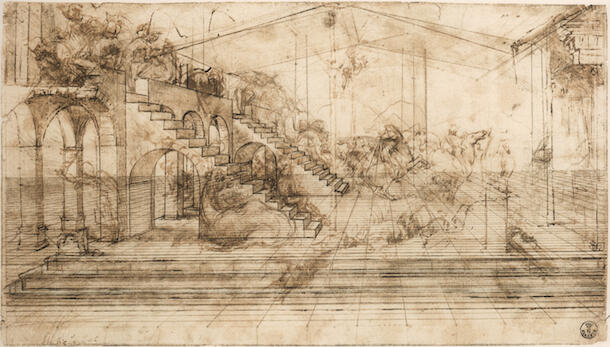The epoch of the Renaissance was marked by a conscious intellectual impulse that began in Italy in the XIV century. The culture of the Renaissance was based on the philosophy of humanism, which affirms the beauty and dignity of a person, the strength of his or her mind and will, as well as creative possibilities. The revival of interest in ancient heritage and return to antique forms in art included a realistic manner in architecture with the development of linear and light perspectives. This paper aims at examining how the Renaissance architects used perspective drawing to communicate and explain architectural constructions.
Architecture occupied a leading place in Renaissance art, which was expressed in simplicity and tranquility of volumes and shapes. The perspective was understood as the science of imaging objects on a surface such as they are perceived by the human eye. The linear perspective gave the possibility of constructing three-dimensional elements in two-dimensional space, developing more detailed forms (Carpo and Lemerle 13).
It should be emphasized that Antiquity and the Middle Age periods solved the problem of finding a volumetric form without interrupting a construction. From the very beginning and through the entire Renaissance period, the principle of artistic individualism and reference to ancient forms remained popular. The rational forms appeared with visually clear boundaries – the key geometric shapes and bodies in the Renaissance architecture were a square, a rectangle, a cube, and a ball.
The first exact formulation of the laws of building perspectives belongs to Filippo Brunelleschi, who discovered the vanishing point on the plane, into which all parallel lines were to be directed (Pictures 1-2). In addition, this architect guessed the scale by calculating the ratio of the length of the figure to the length of the projection in the picture, depending on the distance from the picture plane (Panofsky 5).
Brunelleschi made these discoveries based on the thorough analysis and execution of drawings of ancient Roman buildings. In his turn, Leon Battista Alberti spoke of a picture of the plane as a transparent surface to represent forms of visible objects on this surface as if it were transparent glass (Carman 23). Through the latter, a visual pyramid passed at a certain distance, light, and position of the center of the drawing (Picture 3). Alberti suggested using a grid on the glass when drawing from life to build perspective through distance points where the diagonals of the squares of the floor or the square converged.
The plane solutions of two-dimensional space were replaced by those that create the illusion of depth, allowing the picture and the building to “vibrate” and represent the perspective. All these qualities of the plane help to influence a viewer in different ways – the effective perception of architecture and plane was replaced by the visual perception. The architects became more contemplative and designed a new architectural form and space, thus refocusing on the concept of space rather than a place.
In the history of architecture, there are many examples of drawings and layouts – models of natural and large scales executed in order to verify the artistic and design features of structures. The epoch of the Renaissance brought a new philosophy to architectural design, and the construction of a linear perspective became an organic phenomenon (Carpo and Lemerle 51). There was a process of developing a plane that becomes part of the architectural form.
The planar principle of the image gave rise to the perception of volume, the illusion of depth, the instrument for the achievement of which was a linear perspective. An example of this is the rusticated facades of the palazzo or the painting of churches, which organically continued the volumetric details of the eaves or domes. Thus, Alberti, Brunelleschi, and other architects achieved the unity of volume and plane in an attempt to make buildings look more realistic and, at the same time, reflective of the Renaissance.
The constructive solution of vaults and domes remained the main technical and artistic challenge. The closed arches and domes, which leave a lot of space for murals, were especially popular in combination with the ancient and medieval experience (Panofsky 38). At the same time, it should be stressed that the Renaissance tried to overcome the massiveness and simple accumulation of volumes. For example, Brunelleschi’s Florence Baptistery can be regarded as a revolutionary building that is attracted by its simple yet solemn lineament. To facilitate the construction of the system of vaults, various additional elements were used that were left open and sometimes interpreted as details of the artistic solution.
In conclusion, the Renaissance architects used perspective drawing not only as a method of organizing the space but also as a way of organizing the audience’s perception. The architects set the distance to the drawing plane, which determined the location of a viewer and formed his or her perception. In general, the perspective drawing was applied by that period architects as the representation of humanistic ideas and great abilities of people.
Appendices



Works Cited
Carman, Charles H. Leon Battista Alberti and Nicholas Cusanus: Towards an Epistemology of Vision for Italian Renaissance Art and Culture. Routledge, 2016.
Carpo, Mario, and Frédérique Lemerle. Perspective, Projections and Design: Technologies of Architectural Representation. Routledge, 2013.
Panofsky, Erwin. Renaissance and Renascences in Western Art. Routledge, 2018.